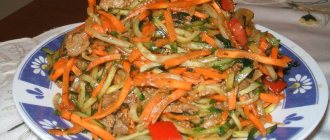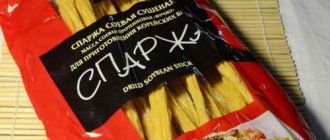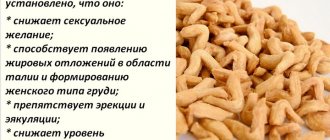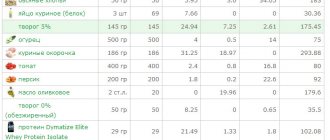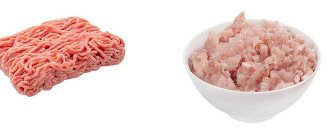Korean asparagus is a delicious and beloved dish by many. For salad use soy asparagus or fuchja. This product resembles a real vegetable only in appearance, but, nevertheless, it has a wonderful delicate taste.
Soy asparagus is a dietary product. It is not high in calories, but contains a lot of protein and is quite nutritious. Many stores sell ready-made salads, but you can prepare this dish yourself. In addition to salads, other dishes are prepared from semi-finished soy products: they are boiled, stewed and fried along with vegetables and spices.
You can find dry asparagus on sale in bags of 400 and 500 g. After soaking, you get approximately 1.5 liters of product, ready for preparing various dishes.
Korean asparagus: calories and benefits
The benefits of soybeans for humans have been known since ancient times. It successfully replaces meat dishes and is used during a diet. Due to the high protein and fiber content, soy asparagus dishes help to quickly saturate and fill the stomach. Therefore, this product is quite popular among people losing weight. 100 g of soy asparagus contains about 440 kcal.
This product is made from soybeans and water processed in a special way. It also contains many vitamins and minerals.
Soybean dishes are beneficial for people suffering from heart and vascular diseases. The high content of polyunsaturated acids helps restore the health of these organs and strengthen the body as a whole.
But, despite all the benefits of asparagus, you should not abuse it. Frequent consumption of soy can cause pancreatic dysfunction. It is useful for people who need to limit meat and other animal products or completely exclude them from their diet.
The product consists of 40% protein, 20% vegetable fats. Soy asparagus contains many amino acids necessary for our body. But there is no cholesterol in it at all.
The calorie content of Korean salads with asparagus is low. On average, 100 g of product accounts for 105 kcal. Calorie content, of course, changes depending on what components the asparagus is mixed with. In this case, the calorie content of the dish can be calculated using a special table.
Korean-style soy asparagus: calorie content per 100 grams of product, what it is made from, its benefits and harms
Chinese and Korean cuisine have become very popular in the modern world. Soy asparagus is a dish of national Asian cuisine. She managed to fall in love with many fans of this cuisine. What are the properties of this popular product and its calorie content? What does it bring to the body, benefit or harm?
- Korean soy asparagus
- Calorie content of the product
This product has several names - fuzhu, fupi, douli yuka. Korean soy asparagus is a salad made from dried soy milk foam. This has nothing to do with asparagus. In China and Japan, this dish began to be consumed a very long time ago. The first mentions of it were recorded in the 15th century.
Soy milk foam does not have an exquisite taste, but residents of Asian countries have been able to improve its taste and make it a savory dish.
In Japan, soy milk foam is eaten raw ; in China it is dried. With the right seasonings, soy milk foam can be given a wonderful taste.
This resulted in a delicious and complete Asian dish.
Soy asparagus is made from soybeans. They are crushed and then boiled; at the time of cooking, foam rises above the milk; it is collected and then hung . In this form, it becomes fibrous, after which it is dried and goes on sale.
The product contains a lot of protein, which is why it is used by vegetarians and athletes. The vegetable protein in soy asparagus is completely absorbed by the body. In addition to protein, it also contains a lot of other useful substances:
- minerals;
- vitamins;
- insoluble fibers.
From it they learned to prepare natural soy sauce, milk and cheese for vegetarians. The product contains a large amount of:
- gland;
- magnesium;
- calcium;
- Selena;
- phytoestrogens.
Soy asparagus is rich in fiber, which helps eliminate constipation and improves the functioning of the digestive system.
Soy protein and insoluble plant fiber help lower blood cholesterol levels.
Polyunsaturated fatty acids serve as a prophylactic for the cardiovascular system. Plant estrogens help reduce the risk of breast disease in women.
Due to the selenium content in the product, when consumed regularly, the likelihood of prostate and colon disease in men is reduced.
A high content of amino acids can renew the cells of our body, which improves the condition of the skin and muscles and slows down the aging process of the entire body . If you regularly eat Korean asparagus salad, your hair becomes much better and practically does not fall out. Thanks to phytohormones, soy asparagus is an excellent preventive remedy for osteoporosis.
Calorie content of the product
If we talk about the calorie content of Korean asparagus, this indicator may differ depending on the type of product. It is purchased in two forms - dried or ready-to-eat. The calorie content of the finished dish is 440 kcal per 100 g:
- proteins – 45 g – 180 kcal;
- fats – 20 g – 180 kcal;
- carbohydrates – 20 g – 80 kcal.
The energy value of finished Korean-style asparagus, the BZHU ratio looks like this:
- proteins – 41%;
- fats – 41%%
- carbohydrates – 18%.
This caloric value will allow you to quickly saturate your body and not gain extra pounds. The dish began to be often included in the menu of various diets . If you compare the dish with other protein products, you will immediately notice that it contains more protein and much fewer calories.
Harm or benefit
Research has been carried out repeatedly in the field of soy products. Most scientists believe that excessive amounts of soy foods are harmful to health. Soy can negatively affect the condition of the pancreas . The phytoestrogens contained in soy can cause disorders of sexual development in childhood, and in women lead to disruption of the thyroid gland.
Doctors believe that soy products should be introduced into your diet with caution. No matter how tasty a Korean asparagus dish turns out, you need to eat it little by little and not every day. Only small portions of such a product can benefit the body.
Not long ago it was allowed to use GMOs in the production of soy products , so when buying them you should always pay attention to this indicator. If you constantly consume foods with GMOs, there is a risk of developing cancer.
Korean asparagus is very rich in protein, with a high content of amino acids. Soy asparagus has a pleasant taste. It is used to prepare salads and side dishes, appetizers, and is used as an independent dish. If you prepare a dish correctly, it will reveal all its valuable properties and give you the opportunity to enjoy a pleasant taste.
Preparation:
- Cut the prepared asparagus into thin strips. Grate the carrots (it is better to use a special grater for Korean carrots).
- In a deep bowl, combine asparagus, carrots and pressed garlic.
- Prepare a dressing from vegetable oil, sugar and salt. Place the saucepan on low heat, add red and allspice, and spices to taste.
- When the dressing boils, put a bay leaf in it, pour in the vinegar and immediately remove from the heat.
- Season the asparagus with vegetables with the resulting sauce, mix thoroughly. Leave the asparagus in the refrigerator for at least 3 hours, but the dish will be much tastier and more aromatic if you leave it for 12 hours.
Preparation:
- Rinse the pickled mushrooms under running water to remove mucus and cut into thin slices.
- Cut the pre-soaked asparagus into thin strips. Also chop the peeled radish.
- Combine radishes and mushrooms, add salt and leave for 10 minutes. During this time, juice will be released, which must be drained so that it does not make the salad watery.
- After the juice has been drained, add asparagus and finely chopped green onions to the salad.
- In a separate container, mix sesame oil, vinegar (can be replaced with lemon juice) and spices.
- Season the salad with the resulting sauce. Leave in the refrigerator for 3-5 hours.
From soy asparagus you can prepare many interesting and tasty salads that will diversify your daily diet and complement the holiday menu. During your diet, eating a small amount of asparagus will also be beneficial. In addition to vegetable salads, you can also cook meat dishes with fuju by adding chicken or pork. Thinly sliced asparagus will enhance the flavor of rice and bean noodle dishes.
by the materials LadySpecial.ru
Soy asparagus (fuju): benefits and harms, calorie content, photos, recipes
Soy asparagus is a popular semi-finished product made from soybeans. It is an integral element of East Asian cuisine. The benefits and harms of soy asparagus cause a lot of controversy between nutritionists and nutritionists, but its beneficial properties are very effective.
What is soy asparagus and what is it made from?
This is a healthy herbal product. In the Russian-speaking space, it received the erroneous name “asparagus,” although this semi-finished product has nothing to do with this type of plant grown in the ground.
Its real name is fuzhu, it comes from the Chinese language. The beneficial properties of asparagus from soybeans were noted by residents of the east in ancient times. The Koreans call it yuba, and the Japanese call it doupi.
In Russia, this product is also called “Chinese fern” or “Korean-style asparagus.”
To prepare dry asparagus, soybeans are used, which bring great benefits to the body due to minerals - potassium, magnesium, calcium, iron. The process consists of several stages. First, the soybeans are filtered and soaked in water.
Next, special devices are used to separate the soy curd from it. Soy milk is prepared from the remaining product and boiled. A fatty layer called fupi forms on the surface. It is removed, hung, and left to dry for a while.
At the end of the process, long, wrinkled sheets of familiar shape are obtained. This is a ready-made product - fuzhu.
Calorie content of soy asparagus
The calorie content of dry soy asparagus per 100 grams is 260 kilocalories. Due to its relatively low calorie content and abundance of beneficial properties, it is often used in dietary nutrition. proteins per 100 g – 42 g, carbohydrates – 23 g, fats – 14 g.
Advice! To further reduce calories, you can use special cooking methods. For example, Korean pickled asparagus is lower in calories, does less harm and is more beneficial.
What are the benefits of soy asparagus?
It is often called the “product of youth”: fuzhu has a high concentration of essential plant protein, which is absorbed by the body much faster and easier than animal protein.
Soy asparagus has many health benefits, but some studies show that it can also be harmful if consumed in excess.
Eating fuju in a very large amount negatively affects the functioning of the pancreas and thyroid gland, and also harms the digestive processes due to its high fiber and protein content.
https://youtu.be/ITMubFuA_bU
This product contains bioactive substances - phytoestrogens. For women, they are of great benefit: consuming soy asparagus during PMS, menopause, or when the reproductive system is unhealthy will help reduce the risk of developing serious diseases and reduce harm from the influence of unfavorable factors.
Isoflavones, a type of phytoestrogens contained in fuju, which have many beneficial properties, are excellent antioxidants, normalize hormone function, and promote anti-carcinogenic changes.
Soy asparagus contains a special substance, lecithin, whose properties improve liver function and prevent the accumulation of fat in the body.
What diseases does soy asparagus help with?
The benefits of asparagus from soybeans include the prevention of certain cancer diseases, heart and vascular problems. The product has a very low cholesterol content and no lactose, so it is suitable for people with diabetes and allergies to milk sugar. This is an indispensable source of protein for athletes and simply people who do not eat animal products.
The benefits and harm of asparagus in Korean
The benefits of dried soy asparagus are undeniable, but despite this, there are several other points that prove the harm of this product in special situations.
- By including this healthy semi-finished product in your regular diet, you can get the vitamins and beneficial elements your body needs every day: vitamins B, D, E, iron, potassium, sodium.
- Korean asparagus is beneficial for the body of people with diseases of the cardiac system, disorders of the gastrointestinal tract, dysbacteriosis, diseases of the musculoskeletal system, and chronic constipation. The product also neutralizes the harm caused by the effects of junk food on the body.
- This product is one of the leaders in the amount of polyunsaturated fatty acids, so fuju soy asparagus benefits people suffering from hypertension, heart disease, and atherosclerosis.
- For men and women who lead an active lifestyle and play sports, soy asparagus provides benefits in the form of an abundance of essential, easily digestible plant amino acids.
- Fuzhu contains a lot of useful fiber, which improves metabolism, reduces harm from the effects of fatty foods and helps remove toxins from the body.
- Nutrition experts do not advise consuming it in excessive quantities, since its properties can harm the functioning of the endocrine and mixed secretion glands - pancreas, thyroid, and also impair the functioning of the human reproductive system.
- Excessive consumption of fuju, like any other product, can lead to inevitable weight gain. Therefore, you need to take a rational approach to meal planning and consume all foods in moderation.
Korean soy asparagus for weight loss
Due to the low calorie content of Korean asparagus, it is often used in various weight loss programs and diet courses. Korean asparagus has a pleasant taste, so it should be included in the daily diet not only for those who want to lose weight and follow a strict diet, but also for those who want to diversify their diet.
Important! Nutritionists advise eating this semi-finished product in the afternoon - for lunch or dinner. Thus, healthy vegetable protein will be absorbed in the best possible way and will bring more benefits to the body, and carbohydrates and fats will not be deposited in the body as excess weight and will not cause any harm.
How to cook soy asparagus at home
It's very easy to prepare: it won't take more than 30 minutes, but some preparation is required.
- The dried product must be soaked in cool water for at least 4 hours. If it is not possible to leave it for such a long time, then you can simply pour boiling water over the fuju and leave it for a couple of minutes to swell. But with this method of cooking, the taste will be much less pleasant, and many of the aromas and beneficial properties of soy asparagus will not be fully revealed.
- After soaking in water, it needs to be washed and cut into pieces.
- As a supplement, you can choose any healthy vegetables: most often, these are onions, carrots, as well as legumes - beans, chickpeas.
- First, the vegetables are fried in vegetable oil in a deep frying pan until medium cooked and only then soy asparagus is added.
- Next, you need to thoroughly mix all the ingredients and leave to simmer under the lid for 7 - 10 minutes.
- For decoration and the final touch, you can sprinkle the dish with herbs - green onions, dill, then crush the garlic and sprinkle with pepper.
Delicious and healthy dishes made from soy asparagus
Fuzhu is used not only as an independent dish, but also as an integral element of many other healthy and tasty recipes. Basically, all dishes that include soy asparagus come from the cuisines of East Asian countries - China, Japan, Korea, India:
- With carrots in Korean;
- Korean asparagus with paprika;
- Diet Caesar with soy asparagus;
- Oriental salad with fuju, seaweed and pickles;
- Autumn salad with pumpkin, pear and fuju.
Korean asparagus recipe with carrots
Korean asparagus with carrots is one of the traditional dishes of oriental cuisine, which is prepared there in every home. To prepare this dish you will need the following ingredients:
- dried semi-finished product - 1 package;
- vegetables: onions and green onions, garlic - 3 - 4 cloves, carrots - 1 kg;
- various seasonings to taste. The main ones are black pepper and coriander;
- soy sauce - 1 tbsp. l.;
- vegetable oil (linseed, olive, sunflower, pumpkin or grape seeds);
- vinegar 70% - 1 - 1.5 tbsp.
First you need to soak the fuju.
- Next, start cooking carrots in Korean. To do this, all the carrots must be chopped on a fine or coarse grater (optional), add ground pepper, salt, 1 - 2 tbsp. l. vinegar and leave to infuse for 15 - 20 minutes.
- After this, finely chop the onion and garlic, fry them in vegetable oil in a frying pan along with coriander, add asparagus.
- Pour soy sauce over the entire mixture, stir, and leave to fry for another 5 - 6 minutes. until fully prepared.
- You need to transfer everything from the frying pan to the carrots and put the salad in the refrigerator.
The dish is usually served cold: this is how its taste properties are most noticeable.
Korean asparagus with paprika
This is another popular recipe for making Korean asparagus with your own hands.
First, you also need to soak the dried product in water for several hours.
Meanwhile, you need to prepare the marinade for soy asparagus:
- The base is soy sauce, in which ground black pepper, salt, 1 - 2 tbsp are mixed. l. fragrant paprika, crushed garlic and finely chopped onion.
- The swollen mass is placed in the resulting marinade and left in the refrigerator for 12 hours.
Important! This recipe is complicated because if you overcook the asparagus in soy sauce, its taste will become cloying and sour.
Harm of soy asparagus
It is not recommended to eat too much fuju, as this can lead to an exacerbation of certain endocrine diseases. In young children, excessive use can lead to future problems with the reproductive system. In general, the harm of this product to the body is quite insignificant, especially if you use it no more than 4 - 5 times a week.
Who is contraindicated in soy asparagus?
People with pancreatitis, as well as those with kidney disease, problems with the endocrine glands - hypofunction of the thyroid gland should refrain from consuming fuju. However, you should not completely exclude this useful product from your diet, since in small quantities it will only bring benefits.
How to select and store soy asparagus
Soybeans were the first product on which scientists tested GMO technologies. Therefore, unfortunately, now unscrupulous manufacturers often find fuju made from low-quality, low-grade soybeans. You must always read the text on the packaging: study the composition, production methods, properties of the product.
It can be safely placed on the same shelf with pasta, cereals, and legumes. It is advisable to choose dark cabinets or shelves.
Conclusion
Thus, it turned out that the benefits and harms of soy asparagus depend only on the quantities in which it is consumed. Fuzhu has a lot of beneficial properties, it is rich in essential vitamins and essential elements, so this product must be constantly included in your daily diet. about preparing soy asparagus:
Did you find this article useful? Korean asparagus: benefits and harms, what it is made from, calorie content Link to main publication

